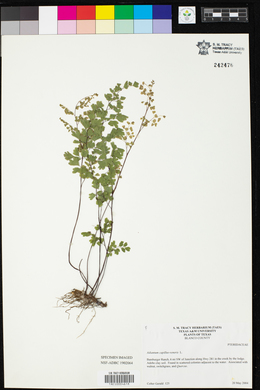Adiantum capillus-veneris
|
|
|
|
Family: Pteridaceae
common maidenhair, more...Southern Maidenhair, maidenhair fern, common maidenhair fern, venus hairfern (es: helecho de la virgen, cilantrillo, culantrillo)
[Adiantum africanum, moreAdiantum capillus , Adiantum capillus-veneris f. cristatum Moxley, Adiantum capillus-veneris var. kenyense Chiov., Adiantum capillus-veneris var. modestum (Underwood) Fern., Adiantum capillus-veneris var. pinnata Bonap., Adiantum capillus-veneris var. protrusum Fern., Adiantum coriandrifolium Lam., Adiantum fontanum Salisb., Adiantum fumarioides Willd., Adiantum marginatum Schrad., Adiantum modestum Underwood, Adiantum paradiseae Baker, Adiantum pseudocapillus Fée, Adiantum schaffneri , Adiantum trifidum Willd. ex Bolle] |
Stems short-creeping; scales golden brown to medium brown, concolored, iridescent, margins entire or occasionally with single broad tooth near base. Leaves lax-arching or pendent, closely spaced, 15--75 cm. Petiole 0.5--1.5 mm diam., glabrous, occasionally glaucous. Blade lanceolate, pinnate, 10--45 × 4--15 cm, glabrous, gradually reduced distally; proximal pinnae 3(--4)-pinnate; rachis straight to flexuous, glabrous, not glaucous. Segment stalks 0.5--3.5 mm, dark color extending into segment base. Ultimate segments various, generally cuneate or fan-shaped to irregularly rhombic (plants in American southwest occasionally with segments nearly round), about as long as broad; base broadly to narrowly cuneate; margins shallowly to deeply lobed, incisions 0.5--7 mm, occasionally ± laciniate, sharply denticulate in sterile segments; apex rounded to acute. Indusia transversely oblong or crescent-shaped, 1--3(--7) mm, glabrous . Spores mostly 40--50 µm diam. 2 n = 120. Sporulating spring--summer. Moist calcareous cliffs, banks, and ledges along streams and rivers, walls of lime sinks, canyon walls (in the American southwest), around foundations, on mortar of storm drains; 0--2500 m; B.C.; Ala., Ariz., Ark., Calif., Colo., Fla., Ga., Ky., La., Miss., Mo., Nev., N.Mex., N.C., Okla., S.C., S.Dak., Tenn., Tex., Utah, Va.; Mexico; West Indies; Central America; South America in Venezuela, Peru; tropical to warm temperate regions in Eurasia and Africa. No evident pattern to morphologic variation in the species is discernible, although a number of segregate species and infraspecific taxa have been recognized within North American Adiantum capillus-veneris . In the Eastern Hemisphere, the species is diploid, with 2 n = 60 (I. Manton 1950). Several tetraploid counts have been reported from North America (W. H. Wagner Jr. 1963). Spore-measurement data suggest, however, that the polyploid cytotype may not be widely distributed. Further investigation is needed to determine whether Adiantum capillus-veneris populations in North America are conspecific with those in Eurasia and Africa.
General: Short creeping stems, with golden brown to medium brown scales, iridescent with entire or with a single tooth near the base; numerous fronds lax-arching or pendent, closely spaced, 15-75 cm in length. Leaves: Blade ovate-lanceolate and pinnate, 10-45 cm long by 4-15 cm wide, gradually reduced above; each pinnule on stalks 0.5-3.5 mm dark colored extending into segment base; ultimate pinnules generally cuneate to fan-shaped to irregularly rhombic, about as long as broad, base broadly to narrowly cuneate; margins shallowly lobed to deeply incised on outer margins, apex rounded to acute. Sporangia: Indusia transversely oblong or crescent-shaped, 1-3 mm, glabrous. Ecology: Found on moist sites, usually along cliffs or wet, rocky banks, often in limestone from 1,500-7,000 ft (457-2134 m); sporulates spring-summer. Notes: Distinctive with its delicate fan-shaped pinnules at the end of stalks which are often a dark purple along water. Ethnobotany: Used for rheumatism, as a lotion for bee and centipede stings, and the plant is taken as a cure for insanity. Etymology: Adiantum is from Greek adiantos meaning unwetted or unwettable, while capillus-veneris is from Greek words for hair and Venus. Sources: FNA 1993, Dittmer et al. 1954, Kearney and Peebles 1969 FNA 1993, Dittmer et al. 1954, Kearney and Peebles 1969 Common Name: common maidenhair Wetland Status: FACW General: Short creeping stems, with golden brown to medium brown scales, iridescent with entire or with a single tooth near the base; numerous fronds lax-arching or pendent, closely spaced, 15-75 cm in length. Leaves: Blade ovate-lanceolate and pinnate, 10-45 cm long by 4-15 cm wide, gradually reduced above; each pinnule on stalks 0.5-3.5 mm dark colored extending into segment base; ultimate pinnules generally cuneate to fan-shaped to irregularly rhombic, about as long as broad, base broadly to narrowly cuneate; margins shallowly lobed to deeply incised on outer margins, apex rounded to acute. Sporangia: Indusia transversely oblong or crescent-shaped, 1-3 mm, glabrous. Ecology: Found on moist sites, usually along cliffs or wet, rocky banks, often in limestone from 1,500-7,000 ft (457-2134 m); sporulates spring-summer. Notes: Distinctive with its delicate fan-shaped pinnules at the end of stalks which are often a dark purple. Ethnobotany: Used for rheumatism, as a lotion for bee and centipede stings, and the plant is taken as a cure for insanity. Etymology: Adiantum is from Greek adiantos meaning unwetted or unwettable, while capillus-veneris is from Greek words for hair and Venus. Synonyms: Adiantum capillus-veneris var. modestum, A. capillus-veneris var. protrusum, A. modestum Editor: SBuckley, 2010 Rhizome short-creeping, 1.5-2.5 mm thick, its slender dark brown scales 1.5-3 mm, scarcely 0.5 mm wide; lvs scattered, lax, mostly 1-4(-5) dm overall; petiole purplish-black, nearly or fully as long as the blade; blade (once or) twice (or in part thrice) pinnate, mostly 2-4 times as long as wide; pinnae alternate, few, mostly 5-12 on each side; ultimate segments petiolulate, subflabellate or rhombic, deeply parted with dentate lobes, lacking a midrib; fertile pinnules slightly smaller than the sterile; 2n=60. Moist calcareous rocks and banks; Va., Ky., Mo., S.D., and Utah, s. to the tropics, and in warmer parts of the Old World; sometimes escaped farther north. Gleason, Henry A. & Cronquist, Arthur J. 1991. Manual of vascular plants of northeastern United States and adjacent Canada. lxxv + 910 pp. ©The New York Botanical Garden. All rights reserved. Used by permission. |
|
|
|





























































































